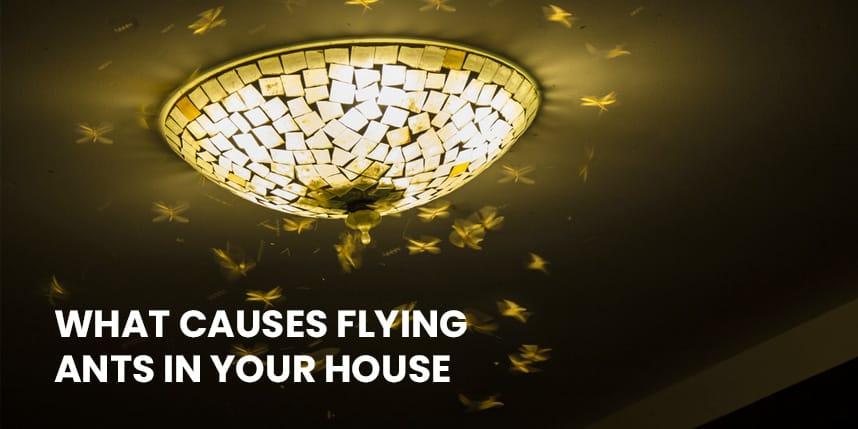What Causes Flying Ants in Your House
02 Sep 2021
Introduction: - Flying ants are different ant varieties that belong to the ant genus. They're generally located in homes, trees, and gardens. These ants are most prevalent during the monsoon season. This is the most fertile period for the ants of this insect class. Monsoon is an excellent period for them to develop and begin their journey for a suitable location to set their new ant colony.
The procreative system of these ants is added reason for starting a new settlement in this period. This season, they look for experienced male and female ants to complete the reproductive system. If you are not aware, these and may build their next possession at your home. Let’s give stress on how to get rid of flying ants in this discussion.
What Are Flying Ants in The House?
Flying ants are just regular ants that can be found virtually everywhere. ‘Alates’, oftentimes perceived as flying ants, are the only platform at which mere ants are ready for sex and breeding. During the rainy period, simple ants develop into sexually mature ants, which are consequently assigned to as flying ants.
Throughout this time, they ordinarily look for a tranquil spot to function their new colony. They don't have any Wings on their bodies this time. According to much analysis, flying ants have a short-term lifespan. They lead the end of their lives after reproducing.
Be circumspect if you have noticed a group of flying ants in any segment of your home, individually in wooded areas. Let’s learn the activities of flying ants in-house.
And they are remarkably damaging to wooden objects, generating enduring resources waste. But the good news is that they are not venomous and have no inclination to bite. In general, flying ants do not pose a meaningful warning to humans. However, they might be hazardous to your residence and furniture.
Although they are not that dangerous, they can be bothersome sometimes. However, their tunnelling efforts are crucial in increasing growth. Their swarming occurrences also provide a valuable food supply for a variety of ant species.
What Are Types of Flying Ants?
Winged pavement ants, carpenter ants, flying ants, and termites are just a few examples of very common flying household insects. When they fly over you, they may appear to be the same, but if you catch them resting and not in flight, you can distinguish flying ants in the house.
1- Winged Pavement Ants: -
Queen Pavement ants produce swarmers, which are reproductive ants with wings. Swarmers break away from the colony to mate and start new colonies. Winged pavement ants swarm in June and July.
2- Carpenter Ants: -
Carpenter ants get their name from chewing through the wood to construct their nests. They do not, however, eat wood like termites. Sweet foods, pet food, and other insects are among the foods they consume.
These ants are common in wooded areas, where they build their nests in trees, logs, and stumps.
3- Flying Ants: -
Entomologists call these ants "alates," or "flying ants." The winged ants prepare to take center stage when the ant colony is naturally ready to expand.
4- Termites: -
Termite is a cellulose-eating insect whose social system is strikingly similar to that of ants and bees, although it evolved independently. Termites are sometimes referred to as white ants, even though they are not related to ants.
Flying Ant’s In-House Summer
Reason For Appearing Flying Ants in Summer:
Moisture, light, and wood are all important to flying ants. These ants may be spotted loitering beside a pool, swarming after a fresh rain, or even flying around in the late summer humidity. You may find flying ant’s in house summer for a couple of reasons. Moisture is something that these ants crave and will go out of their way to find it.
Some people claim to see flying ants swarming around lights, even though no one knows why. Flying ants usually stay outside of the house, but if you spot one inside or a swarm inside, they may have entered through a foundation fracture and established a nest. The ants are frequently found near the home's foundation, as well as near trash cans and outbuildings.
1- Ways To Prevent Them:
Flying ants may wreak havoc on your home and property. Here are some strategies for dealing with flying ants once you've identified them.
2- Apply The Process of Vacuum: -
To get the swarm out of the nest or hiding location, vacuum them right away.
3- Repair Damaged Wood: -
Obviously, you want to keep your house in good form, but by repairing damaged wood, you can save the damage from getting worse.
4- Seal If There Is Any Crack: -
Seal any cracks to prevent ants from flying inside and causing harm.
Flying Ants Attracted to Light
It's an unusual nature you may observe among numerous insects. They have a universal charm to the lights. Specifically, like other insects, winged ants are also very attracted by the source of light. There may be some compelling analyses behind such an appeal among the insects. Some inquiries are carrying that flying ants get strength from light.
If flying ants have chosen your house as their next home, then you have to prepare with some precautions. For example, it is better to use bright lights when possible.
You can use dim lights to get rid of these insects. Flying ants can be very vexatious when someone is working in the kitchen. Particularly when you are cooking food, they generate a real uneasiness. So it is better to use less powerful lights in the kitchen.
It will surely reduce their activity. Otherwise, there is a smart way to get rid of the irritating movement of flying ants. You can use the electrical bug zapper to stop them.
Flying Ants in House in Spring
As we discussed before, the flying ants proceed to our homes for developing their generation method. If you are seeing flying ants in the house in the spring season also, then it has an implication. That is, your house has a fitting environment for their intimate adult life. Definitely wall of your house and furniture is in a bad tone that is encouraging the winged ants to build their new colony.
Because in spring they only choose the place where they find some damp. It is a fair hint that your house lacks proper maintenance.
Large black pants with wings have a similar appearance to wasps. You have to plan the measures to control the increasing growth of these ants. Firstly, in the initial stage, you can do it on your own. You can infestation with chemicals and medicines that prevents the activity of the ants.
If it seems not possible, then you may take the help of professional people. Several good organizations can help you to save your house from damage due to the excessive activeness of flying ants.
How to Get Rid of Flying Ants inside the House?
If you suffering from serious trouble from ants, bugs, and flying ants and you are finding proper ways of how to get rid of flying ants, then you must follow upcoming points. It will help you a lot.
1- Use a Commercial Sprayer: -
If you find that home cures aren't enough to keep away flying ants in the house, you can turn to one of the many commercial bug sprayers on the market. Flying ants should be able to be eliminated using commercial bug spray. However, read all of the instructions on the spray bottle before spraying ants and pests.
This aerosol contains a toxic substance that can cause harm to people and other animals. Protect yourself and your pet thoroughly before spraying.
2- You Can Spray Dish Washer Soap: -
Can you believe that dishwasher soap can get rid of ants in our house? Yes, dishwasher soaps are useful at removing flying ants. This spray may be made at home. Combine dishwasher gel and water in a spray container and shake thoroughly. When sprayed on flying ants, it adheres to their bodies, dehydrates them, and eventually kills them.
3- Peppermint Spray Is Also Good: -
Peppermint oil is a natural insecticide that is particularly effective in killing flying ants. Flying ants will be suffocated by the powerful scent of peppermint oil. Combine water, dish soap, and peppermint oil in a spray container. It's time to use your ant-killing spray.
What Are Flying Ants Attracted To?
Ants, beetles, and flies of all kinds are drawn to warm, humid environments. Flying ants are attracted to houses and fly around the lights, especially when it rains. Apart from that, flying ants are attracted to light. When breeding season arrives, queen flying ants will fly to a new location, and male flying ants will soon follow.
The male flying ant dies after mating, and the female moves on to find a new nesting site. If you notice flying ants on your property, take measures since you will soon observe a large number of them.
Flying ants adore lights, as we've already said. They enjoy warm, well-lit environments, which is why you'll find them fluttering about lights. Sweet dishes are also a favorite of flying ants. If you fail to close your windows and don't cover sweet foods, you'll quickly notice flying ants swarming throughout your home.
As a result, always keep your food secure by storing it in a container. Apart from that, make sure your chimneys are in good working order because flying ants prefer higher spots. If your chimneys have cracks, repair them as soon as possible.
How to Get Rid of Flying Ants in Wall Cavity?
Even if you take good care of your home, you will not be able to prevent flying ants or bugs from entering. You've just finished cleaning the surface of your cabinet when an ant or an insect appears. Then it's only logical to wonder why there are ants on the freshly cleaned surface in the first place.
The majority of people seek assistance during the summer months; they state that they can see more number of flying ant’s in house summer.
Their eggs grow faster in hot and warm temperatures. Natural products are also efficient to get rid of flying ants in the wall cavity, even if chemical aerosols are widely available.
Without holes, ants and flying ants could not enter your home. Flying ants must be able to go into the wall through holes and fissures. You can do one thing, which is to exterminate the entire flying ant colony. However, there are two methods for eradicating flying ants from your home.
Peppermint oil and dishwasher soap can be used to generate an all-natural spray. Chemical mixtures, such as borax and sugar can also be used. It clings to ants and kills them over time.
Do Flying Ants Eat Wood?
If you notice broken sections near your wooden furniture, you can be sure that flying ants are rotting it. Few ant species prefer to consume wood, and this is an unusual occurrence. However, it is not hard or solid wood. Some ants like to live in decayed wood. Ants do not completely consume wood; instead, they chew only the sections that are chewed, resulting in dusty wooden flecks and damaged wood.
However, double-check that it's just ants. Termites prefer softened woods as well. Termites may eat any type of wood, although softwoods are the easiest to destroy. Termites are wood-eating insects that usually target wooden furniture.
What are the Differences between Ants and Termites?
Both termites and flying ants gather in a herd when the mating time arrives. In fact, in naked eyes, sometimes it is hard to distinguish between flying ants and termites. But they have many dissimilarities. In this discussion, we are going to give vital points that will clear your concept.
1- The Shape of Their Body: -
One of the major differences between ants and termites is their body shape. Though both of them can be found in wooden furniture, their body and features are away from each other. Termites have a broader waist, whereas ants and various species of ants have narrow or tiny waist shapes.
2- Wings Are Different: -
Not all ants have wings. Only flying ants which are close to the reproduction process and termites have wings. Flying ants have tiny hind wings and broader forewings, whereas termites have same-sized wings. Therefore, if you see different-sized wings, then it is flying ant's wings.
3- Food Habit: -
Termites are well known for eating woods, whereas flying ants make their shelter in wooden furniture, but they don't eat woods. Termites fully eat wooden furniture, by cutting with their teeth, they damage wooden furniture. But ants and various species of ants do not eat woods. They eat what usually another ant eats.
4- Key Signs: -
Several signs give you alerts of termites’ deposition in your house. If you see same sized wings here and there in your house, mostly around wooden furniture, then it is termites. On the other hand, you can see ants where you store your food items.
5- Wheel Of Life: -
If you pay serious observation to both insect’s life cycles, you will find clear differences. Termite has three phases in their life, which are egg, larva stage, and adult phase. Whereas ants have four phases during their whole life, which include egg, larva, pupa, and the adult stage. In their wheel of life, male or worker, ants can live for a few days, but queen ants can live for years.
When the mating time arrives in the ant’s lifecycle, the male partner dies after mating with female ants, but after mating, both male and female termites survive and stay together in the same colony.
Conclusion: -
Here in this discussion piece, we have compiled plenty of features regarding the flying ants that enter your home to make their own house. They can be the reason for damages to your home's wall as well as furniture. So stay safe from their attack. If needed, please take the help of professionals.
Categorised in: All News












